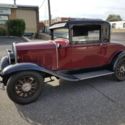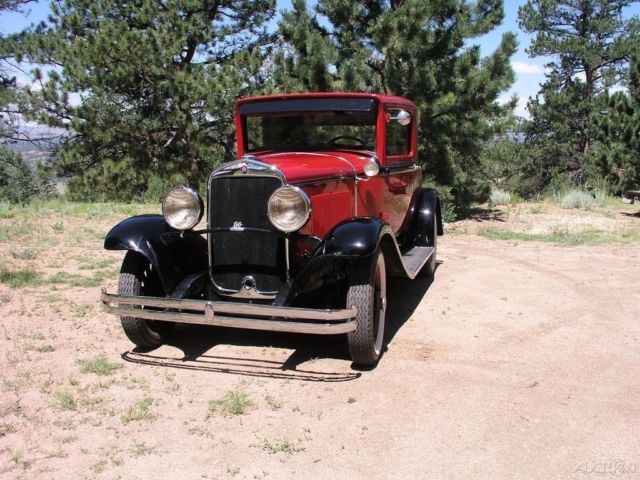1930 Chrysler 66 Used Manual RWD Coupe
- Price:
- Condition: Used
- Make: Chrysler
- Model: Other
- Type: Coupe
- Doors: 2 Doors
- Year: 1930
- VIN: H2204P
- Color: Black
- Engine size: 218.6
- Transmission: Manual
- Drive type: RWD
- Interior color: Tan
- Vehicle Title: Clear
- Location: Colorado Springs, Colorado, United States
Description
1930 Chrysler Model 66 For Sale in Colorado Springs, CO 80906
The correct Serial # for the car is H-220-RP, and the seller obtained the original build card (Build Record Certificate) from Fiat Chrysler. It showed the engine # to be C24714 and that number is stamped on the car’s engine block – so we have the correct build card. It was manufactured in Detroit on 4/7/30 and shipped the next day to Greensburg, PA. Known as a Royal Coupe, it was originally painted a black upper and a cobalt blue lower with a maize stripe. The mileage is exempt.
Part way through the 1930 production year, Chrysler increased the engine piston stroke from 4 ½” to 4 ¾” increasing the piston displacement to 218.6 cu. in. with a 5 to 1 compression ratio and 70 HP at 3,200 rpm. The build card showed that we had the engine with the 4 ¾” piston stroke.
The build card showed that the carburetor was originally equipped with an oiled wire screen air cleaner. Because it had no air cleaner when the seller purchased it, the seller purchased and installed one from NAPA. This item is one of the few non-original parts now in the car.
There are 2 levers in the center of the steering wheel. They both work. One is for light control and the other is for throttle control.
The dash knobs (called buttons) which can be pushed in or out are for manifold heat control, spark advance (pulling it out retards the spark) and choke. They all work. All the gauges (speedometer, odometer, ammeter, oil pressure & fuel) on the dash and the horn also work.
It was determined (from a guy in Canada) that the correct pressure for the “balloon tires” is 40 psi front and 35 psi rear.
The guy that the seller bought the car from said that he used 5 quarts of straight SAE 30 weight (no detergent) oil plus 1 quart of Lucas Oil Stabilizer for the engine. So, that’s what the seller used when the seller replaced the oil on 7/25/16. The seller left the original oil filter and lines to and from it “as is”. It was originally intended to be a bypass filter anyway filtering only 25% of the oil at any one time. The oil filter has not been effective for decades and many cars were not equipped with them in 1930 (in fact, the 1948 Chrysler had no oil filter).
The clutch was taken apart and the components looked new with the exception of the pilot bushing. A new one was machined by a local shop and installed. The grease line from the engine compartment to the clutch throw-out bearing was cleaned out. Now the grease cup can be filled and screwed in to push grease to the bearing. To properly accomplish this, the engine needs to be turned over slightly several times as the grease cup is screwed in. The engagement of the clutch was adjusted to 3” out on the pedal.
The water pump was leaking; so the seller sent it to Vintage Machine Works in Spokane, WA to be rebuilt. The seller installed the rebuilt pump and replaced a pipe plug with a grease zerk. The seller has extra rope packing for the shaft if it needs to be replaced. The seller didn’t over-tighten the fan belt and the seller lube and oil the shaft and tighten the packing nut as necessary.
The 6-volt battery was replaced with a new one on 6/8/15. It has a positive ground (whereas modern cars have a negative ground). The braided cable from the positive battery terminal is connected to the frame. If the seller ever needed to charge the battery (it’s in a small compartment and difficult to see the markings on the terminals), the red positive clamp of the charger needs to go the frame and the black negative clamp needs to be connected to the negative battery terminal that goes to the starter. Make sure the battery charger is switched to 6 volt (not 12 volt).
The brake linings, including the emergency brake lining, were replaced by Pueblo Brake & Clutch. The 8 brake shoes were equipped with 3/16” thick linings, but the brake drums were OK as is. New kits were installed in the brake cylinders as well as the master cylinder. New axle grease seals were installed on all 4 wheels. (While the 4 wheels were off the car, the seller took them to his garage where he sanded and lacquered the oak spokes.) Andy Bernbaum, West Newton, MA provided the rear seals and master cylinder kit.
The fuel pump was rebuilt with a new kit – new diaphragm, new check valve seats & springs and new bowl fine mesh screen with new gasket. The rocker arm and its spring were OK as is. This rebuilt fuel pump has improved the time it takes to start the car. Now it readily starts. The carburetor, a Model BB-1D Carter carburetor was found to be working OK.
The usual 50-50 mixture of coolant (3 gallons) is being used. Although it had been recommended to me that, with the car parked in a heated garage, distilled water only should be used, the modern coolant tends to prevent corrosion. Need to be careful not to overfill the coolant as it will expand and come out the overflow line. The radiator cap can be removed when the engine is hot as the coolant system is not pressurized.
The drive line materials included a new pinion gear seal (at the differential), a new transmission rear seal, 8 lbs of 90 weight gear oil (for the differential), and 4 new bolts, washers & nuts to secure the floorboard. George Bachleda, Olcar Bearing Co, Southern Pines, NC proved to be a good supplier for these seals. The chassis was lubed.
Now for some minor items:
The rubber mat on the passenger side running board was replaced. American Floor Mats, Rockville, MD provided the material.
The T-Handle for the rear window was obtained from the guy in Canada, Dave Hill, Oro-Medonte, Ontario and installed. The rear window rolls all the way down and, surprisingly, the front window raises 3” for good ventilation on warm days.
A hinge mirror was purchased from Bob Drake Reproductions, Grants Pass, OR and installed as the left side rear view mirror. Later a 3” convex mirror was affixed to the hinge mirror to provide better views of traffic in the lane to the left of the car.
And finally, a 500/550 – 18/19” tube was purchased from Coker Tire, Chattanooga, TN and the local Tire King store mounted it and the tire on the split rim that we had received when we purchased the car. Fortunately, the guy who had sold us the car provided us with all the parts to mount the spare tire on the rear of the vehicle. It is very secure and looks real nice.
The mechanical work was done by Mike Moe, Groff’s Auto, Colorado Springs and by Leonard Vahsholtz, Vahsholtz Automotive, Woodland Park. I could not have found two more capable mechanics – they took a personal interest in making the old Chrysler the best it could be.
The above work was done between May 25, 2015 and today, Nov. 30, 2016. This classic car is a must see and drive! Call (402) 502-8385 for more information. 1930 CHRYSLER COUPE RESTORED CAR HOT MOPAR 6 CYLINDER 3 SPEED RUMBLE SEAT COUPE
1930 CHRYSLER COUPE RESTORED CAR HOT MOPAR 6 CYLINDER 3 SPEED RUMBLE SEAT COUPE
Mileage: 56000
 1930 Chrysler CJ Series Six Business Coupe
1930 Chrysler CJ Series Six Business Coupe
Mileage: 10
 Chrysler 1930 3 window coupe like 32 Ford Chev
Chrysler 1930 3 window coupe like 32 Ford Chev
Mileage: 79,006
 1930 Chrysler Series 66 Rumble Seat Coupe
1930 Chrysler Series 66 Rumble Seat Coupe
Mileage: 83,845
 1930 Chrysler C J All Steel body 6 cylinder 3 WINDOW COUPE
1930 Chrysler C J All Steel body 6 cylinder 3 WINDOW COUPE
Mileage: 50000
 1930 Chrysler 77 Royal Coupe offered with ** NO RESERVE ** by Gas Monkey Garage
1930 Chrysler 77 Royal Coupe offered with ** NO RESERVE ** by Gas Monkey Garage
Mileage: 166,247
 1930 CHRYSLER RUMBLE SEAT COUPE TWO TONE PAINT NICE RESTORED CAR MOPAR MODEL A
1930 CHRYSLER RUMBLE SEAT COUPE TWO TONE PAINT NICE RESTORED CAR MOPAR MODEL A
Mileage: 6
 1930 Chrysler CJ-6
1930 Chrysler CJ-6
 1930 Chrysler Roadster Six
1930 Chrysler Roadster Six
Mileage: 12,059
 1930 Chrysler series 66
1930 Chrysler series 66








